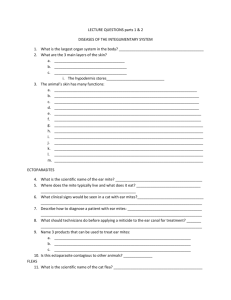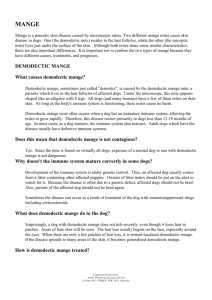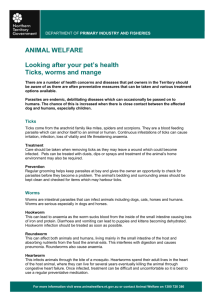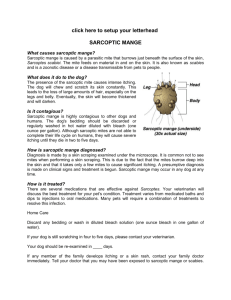CANINE DEMODECTIC MANGE - Alpine Animal Hospital
advertisement
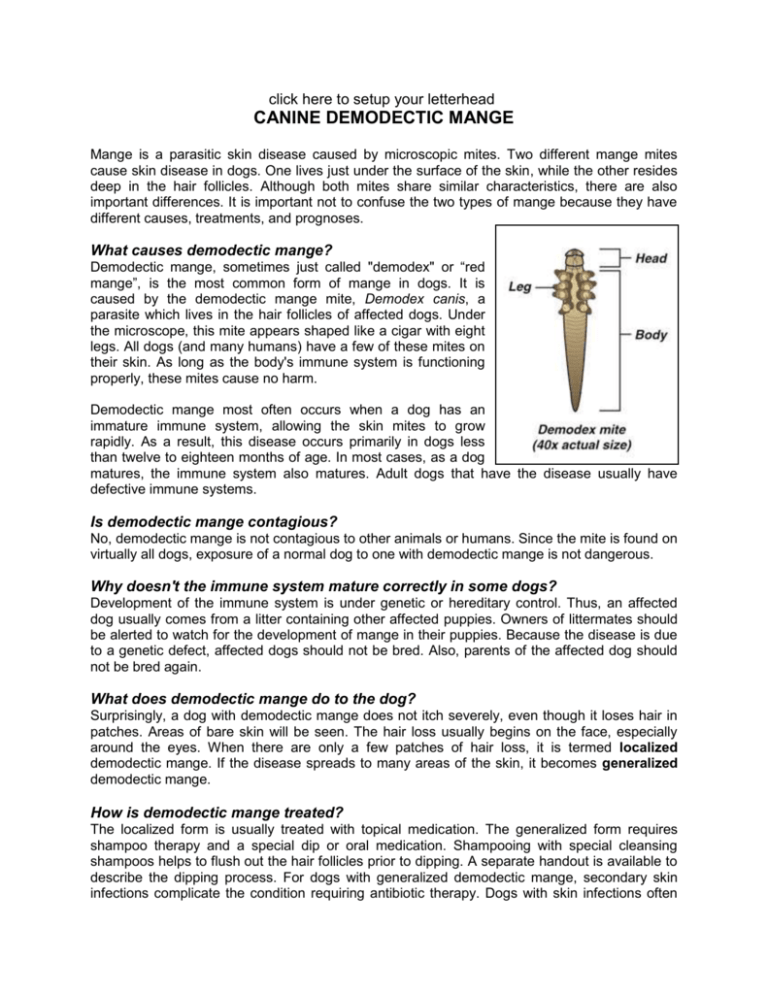
click here to setup your letterhead CANINE DEMODECTIC MANGE Mange is a parasitic skin disease caused by microscopic mites. Two different mange mites cause skin disease in dogs. One lives just under the surface of the skin, while the other resides deep in the hair follicles. Although both mites share similar characteristics, there are also important differences. It is important not to confuse the two types of mange because they have different causes, treatments, and prognoses. What causes demodectic mange? Demodectic mange, sometimes just called "demodex" or “red mange”, is the most common form of mange in dogs. It is caused by the demodectic mange mite, Demodex canis, a parasite which lives in the hair follicles of affected dogs. Under the microscope, this mite appears shaped like a cigar with eight legs. All dogs (and many humans) have a few of these mites on their skin. As long as the body's immune system is functioning properly, these mites cause no harm. Demodectic mange most often occurs when a dog has an immature immune system, allowing the skin mites to grow rapidly. As a result, this disease occurs primarily in dogs less than twelve to eighteen months of age. In most cases, as a dog matures, the immune system also matures. Adult dogs that have the disease usually have defective immune systems. Is demodectic mange contagious? No, demodectic mange is not contagious to other animals or humans. Since the mite is found on virtually all dogs, exposure of a normal dog to one with demodectic mange is not dangerous. Why doesn't the immune system mature correctly in some dogs? Development of the immune system is under genetic or hereditary control. Thus, an affected dog usually comes from a litter containing other affected puppies. Owners of littermates should be alerted to watch for the development of mange in their puppies. Because the disease is due to a genetic defect, affected dogs should not be bred. Also, parents of the affected dog should not be bred again. What does demodectic mange do to the dog? Surprisingly, a dog with demodectic mange does not itch severely, even though it loses hair in patches. Areas of bare skin will be seen. The hair loss usually begins on the face, especially around the eyes. When there are only a few patches of hair loss, it is termed localized demodectic mange. If the disease spreads to many areas of the skin, it becomes generalized demodectic mange. How is demodectic mange treated? The localized form is usually treated with topical medication. The generalized form requires shampoo therapy and a special dip or oral medication. Shampooing with special cleansing shampoos helps to flush out the hair follicles prior to dipping. A separate handout is available to describe the dipping process. For dogs with generalized demodectic mange, secondary skin infections complicate the condition requiring antibiotic therapy. Dogs with skin infections often have very red, inflamed skin. This is the source of the term "red mange." I heard that there is a drug that can be given orally for demodectic mange? Is that true? Yes, with some reservations. Ivermectin is a drug that is used for prevention of heartworms. It is also used for certain parasites on cattle. The cattle preparation has been used orally for demodectic mange in some dogs. In certain dogs it has proven to be successful. However, it is a very strong drug that can cause severe side-effects, including death, if it is not administered properly. It is not approved for use in dogs, so we would only consider using it as long as you are willing to accept liability for adverse effects. What is the prognosis for my dog? Treatment of demodectic mange is generally successful. However, if the immune system is defective, neither the mites nor the infection may respond to treatment. Following successful treatment, is it likely to recur? Because the immune system does not mature until twelve to eighteen months of age, a dog with demodectic mange may have relapses until that age. It is important to treat as soon as a relapse occurs to minimize the possibility of developing uncontrollable problems. Demodectic mange may also occur in older dogs because function of the immune system often declines with age. Dogs who have immune suppression due to illness or medication are also candidates for demodectic mange. The dip commonly used for demodectic mange contains the insecticide amitraz. It must be used cautiously because it is a strong insecticide that can have cause side-effects both to your dog and to you if not used properly. Your dog may experience vomiting and sedation for twenty-four to thirty-six hours following each application. Most of these problems will usually be self-limiting and resolve without medical intervention. If this occurs, the dip should be diluted with 25% more water the next time it is used. Since each dipping results in the development of tolerance to the dip, your dog is less likely to have side-effects with each subsequent treatment. Your dog should be dipped two to three times at seven day intervals and then examined for the presence of live mites or mite eggs. Further treatment will be determined by the results. This client information sheet is based on material written by Ernest Ward, DVM. © Copyright 2005 Lifelearn Inc. Used with permission under license. February 12, 2016

